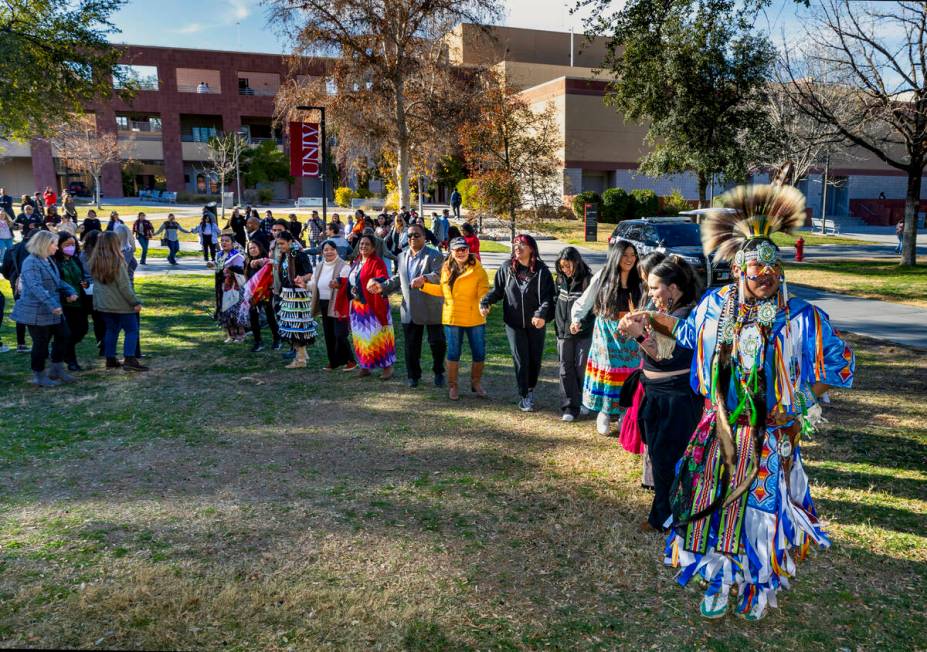‘Season of hope’: UNLV students return for spring semester after shooting

UNLV was again bustling on Tuesday as full, in-person operations resumed for the first time since a shooter terrorized the campus last month, killing three professors, wounding a fourth and sending hundreds into lockdown.
On the first afternoon of the spring semester, students on packed walkways shared conversation and flashed wide smiles as they made their way to class.
Around the same time, members of several Western U.S. indigenous tribes performed traditional singing, dancing and praying in healing ceremonies at an amphitheater overlooking the Beam Hall building.
An armed Anthony Polito, 67, unleashed panic in the business school on Dec. 6.
“Spring is the season of hope and also, for us, a season of healing,” UNLV President Keith Whitfield said before Tuesday’s ceremonies. “We will heal together as we serve as and behave like a community; a community of ‘Rebels.’”
Polito’s victims were Patricia Navarro Velez, 39; Cha Jan “Jerry” Chang, 64; Naoko Takemaru, 69, and a fourth professor who suffered life-threatening injuries.
Polito was killed in a shootout with UNLV police outside the building, according to the Metropolitan Police Department.
Native land
UNLV sits on land once occupied by Southern Paiute people.
“We’re gathered here to bless this ground that we’re on, to acknowledge what we’ve been through and to heal from that,” said Kyle Ethelbah, UNLV director for college programs and a member of the White Mountain Apache Tribe of Arizona.
Chris Spotted Eagle, spiritual leader for the Paiute Nation, led the healing ceremony in prayer, which included seeking God’s peace for the victims’ families.
He noted that tribe members had earlier made their way through Beam Hall in a separate cleansing ceremony.
“We’re not gonna let it define us or carry it on to this year. It’s a new year, it’s a new life, it’s a new time for reckoning,” Spotted Eagle said.
Las Vegas Paiute Tribe Council Chairwoman Deryn Pete explained the ceremonies to the hundreds gathered.
To the rhythm of wooden maracas, “Bird Singers” belted songs in their native tongue.
Female tribe members — including a little girl — slow shuffled to the songs in synchrony.
Pete noted that the prayer dresses wore by “Jingle Dancers” are considered to be “healing to our minds, body and spirit.”
The Moapa Band of Paiutes also participated in the event.
Added its Chairwoman Janet Myers: “When we hear about these senseless acts of violence occurring on U.S college campuses, it really hits home, especially when it happens right here.”
As the music played, a line formed while tribal leaders performed a “smudging,” using sage smoke to cleanse participants.
In a “healing round dance,” dozens of attendees, including Whitfield, linked hands and moved around the amphitheater in what resembled a large snake.
“UNLV is still here, and we’re still thriving,” Ethelbah said.
‘Heal the way that they can’
Suzie Jackson, 18, said her first day back at UNLV had been “kind of chill.”
The second-semester film studies freshman said that the tragedy had been brought up in her two classes.
“I’m glad they’re acknowledging that it happened and that it’s not being brushed over,” she said. “But I definitely think people were trying to just heal the way that they can.”
Dwaipayan Mukhopadhyay — a UNLV math sciences doctoral student who teaches math to undergraduates — said he was seeking normalcy.
“It looks good so far,” he said about the spring semester. “I’m hoping it’s going to be peaceful.”
He said the reopening of Beam Hall — which is closed to students and the public through at least the end of the semester — will help the healing.
Decked in scarlet-red UNLV attire, Bill Robinson said he was “pleasantly surprised that it looks like a normal day.”
Robinson, an economics professor and chair of the faculty senate, is spearheading efforts to permanently commemorate the shooting victims.
Robinson continues to use his space in Beam Hall.
“That’s been my office for 40 years,” he said. “And it’s like home.”
Robinson, who will resume teaching mostly online Wednesday, said he’s worried for his students, and how they’re doing.
“I can’t tell by looking at them whether they’re having problems or not,” he said. “In class, you can look at them and go, ‘I need to talk to that person and I can get them to stay.’”
He also praised the healing event.
“It was nice that the day turned out this way,” Robinson said. “You needed something that could get a lot of people together — especially the people who were in that building on that day.”
Contact Ricardo Torres-Cortez at rtorres@reviewjournal.com.